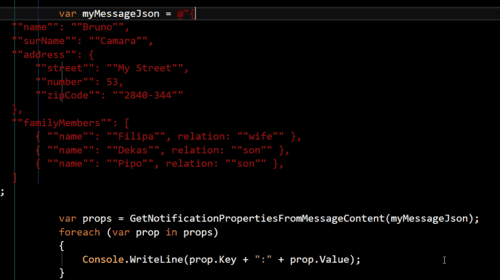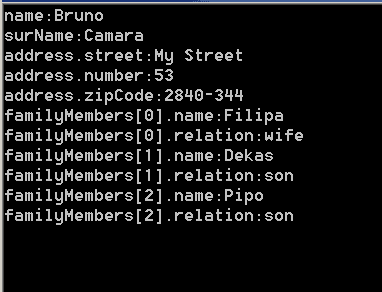Flatten json object to send within an Azure Hub Notification Template
Have you ever needed to flatten your json to a bunch of properties? If yes, continue to read.
When we need to send a notification to an Azure Notification Hub , we can choose from sending a native notification to Windows, Windows Phone, Apple or Google, or alternatively, use the agnostic method which uses templates.
Currently, I am using the template approach, and here is the method signature
public Task<NotificationOutcome> SendTemplateNotificationAsync(IDictionary<string, string> properties);
So, basically we are only allowed to send key value properties.
Let's say that I have a string representing a json object, and I want to send it using this method. To do this, I need to flatten my json (which can have nested objects and arrays inside it) and get a dictionary with all the keys.
Here is an example of json object
{
"name": "Bruno",
"surName": "Camara",
"address": {
"street": "My Street",
"number": 53
"zipCode": "2840-344"
},
"familyMembers": [
{ "name": "Filipa", relation: "wife" },
{ "name": "Dekas", relation: "son" },
{ "name": "Pipo", relation: "son" },
]
}I want to transform this in a dictionary with the following set of key:value
name:Bruno surName:Camara address.street:My Street address.number:53 address.zipCode:2840-344 familyMembers[0].name: Filipa familyMembers[0].relation: wife familyMembers[1].name: Dekas familyMembers[1].relation: son familyMembers[2].name: Pipo familyMembers[2].relation: son
Using the library Json.NET with Linq, it's something that we can do it relatively easy
private static Dictionary<string, string> GetNotificationPropertiesFromMessageContent(string messageContent)
{
JObject jobject = JObject.Parse(messageContent);
return jobject.Descendants()
.Where(j => j.Children().Count() == 0)
.Aggregate(
new Dictionary<string, string>(),
(props, jtoken) =>;
{
props.Add(jtoken.Path, jtoken.ToString());
return props;
});
}Basically we are querying for all nodes that are leafs, and in that case we add its path and value to the dictionary.
Here is a console application

And here is the result of running it

I hope it helps.